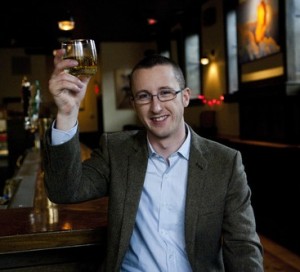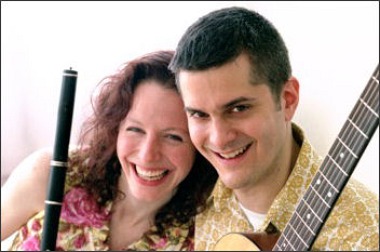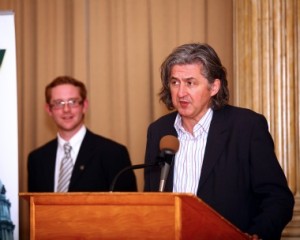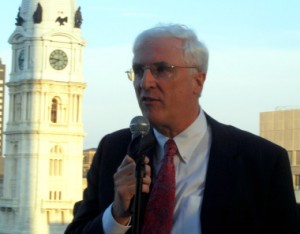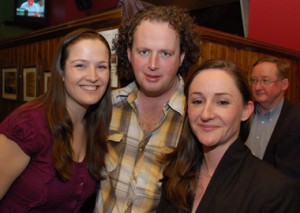Tell us you don’t want Tim Herlihy’s job.
As the United States ambassador for Tullamore Dew, the second-largest Irish whiskey in the world, he has to travel from city to city sharing his knowledge about one of favorite spirits.
He’ll be in town Wednesday night, a guest of Irish Network-Philly at The Bards on Walnut Street, for a whiskey tasting and dinner. He’ll lead whiskey lovers through a tasting of three entries from the Tullamore line—10-year-old reserve, 12-year-old special reserve, and 10-year-old single malt. He’ll also talk about Irish whiskey, once second fiddle to other alcoholic beverages, has become one of the hottest-selling Irish exports.
We asked Herlihy to give us a sneak preview of his presentation. Here’s what he had to say.
Q. There are a lot of whiskeys in the world. How and why are Irish whiskeys different?
A. Irish whiskey is known for being a friendly spirit, smooth, sweet and approachable.
Q. When people taste an Irish whiskey, what should they be looking for? What should their mouths and noses be picking up? Maybe you could tell us what your far more experienced nose and mouth are picking up.
A. Most Irish whiskey is triple distilled, giving it an approachable and smooth taste profile, compared to Scotch, which tend to be more robust. With Tullamore Dew, it’s a triple distilled, triple-blend whiskey, giving it a smooth character, but it’s a whiskey made up of grain whiskey, which gives it a sweetness, malted barley which gives it great citrus fruit flavours, and pot still whiskey which creates a buttery, oily, melt-in-your-mouth texture.
Q. What’s the audience for Irish whiskeys these days? IN-Philly seems to be a younger crowd (though certainly not exclusively), and I’m wondering if younger folks are part of a trend? That is to say, perhaps they go through their college and young adult years, and then they start to crave something more adult in character. Is any of the above true?
A. The new wave of whiskey drinker is enjoying Irish whiskey because of its taste profile, but also because Scotch (by comparison) is seen as a very serious drink. With Irish whiskey, there are no rules; it can be sipped neat, on the rocks, or mixed. The only rule with Irish whiskey is to drink it with friends! Scotch, on the other hand, is a more reflective drink to be had on your own by the fire, plotting the downfall of your enemies.
Q. Tell me about Irish whiskey as a category, Tullamore being the second largest distiller. How has its popularity grown, and how do you account for that?
A. Right now, Irish whiskey is the fastest-growing spirit in the world. Historically at the beginning of the 20th century, Irish whiskey accounted for 60 percent of all world whiskey sales, before suffering a tragic decline due to Prohibition, a trade embargo with the United Kingdom and other factors, which led to Scotch replacing it as the No. 1 whiskey. Today, Irish whiskey is entering a new renaissance with drinkers falling in love with its taste profile, and it’s sociable nature.
5. Tullamore is promoting “Irish True,” a campaign that urges Americans to forget shamrocks and leprechaun costumes, and to focus on the true meaning of St. Patrick’s Day. (irishphiladelphia.com is a shamrock-free zone, so we appreciate the sentiment.) How are you and the folks at Tullamore suggesting we celebrate the occasion, and how is it different from how we typically do, awash in green beer?
A. There’s much more to being Irish than leprechauns, Lucky Charms and pots of gold. Here’s a couple of St.Patrick’s Day tips:
- Kick off the day with a hearty, traditional Irish breakfast; it’s going to be a long day and you’ll need sustenance—my favorites include bacon rashers (real back bacon, if you can get it), both white and black pudding, fried eggs and a strong cup of Irish breakfast tea.
- Take in a local St. Patrick’s Day parade; in Ireland, a parade can be found in a big city, complete with massive floats, right down to a simple tractor parade in a small village. Every city, town and village has its own parade on St. Patrick’s Day. In America it’s no different—go out there and show your support!
- Catch some Irish entertainment; pull up a chair at your favorite pub and listen to a traditional session band.
- Go out and find an Irish True bar or pub; forget the green beer and shamrocks on the wall; an Irish True establishment has its own character and way of doing things; there’s sense of community and camaraderie and, above all, friendship.
- Have a St. Patrick’s Day toast at the ready; toasting is a big part of Irish culture; it should speak from the heart and is meant to be shared with those most important to you.

